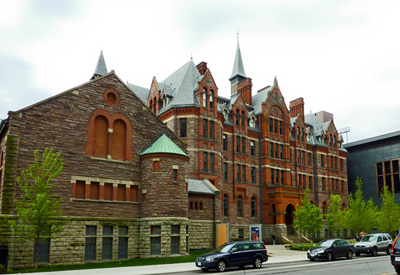Royal Conservatory of Music National Historic Site of Canada
Toronto, Ontario

General view
© Royal Conservatory of Music, Canuckistan, May 2011.
Address :
273 Bloor Street West, Toronto, Ontario
Recognition Statute:
Historic Sites and Monuments Act (R.S.C., 1985, c. H-4)
Designation Date:
1995-07-06
Dates:
-
1880 to 1881
(Construction)
-
1963 to 1963
(Significant)
-
1906 to 1906
(Additional alteration)
-
1990 to 1990
(Restoration)
-
1900 to 1901
(Addition)
Event, Person, Organization:
-
Sir Ernest MacMillan
(Person)
-
Healy Willan
(Person)
-
Langley, Langley and Burke
(Architect)
-
Kuwabara, Payne, McKenna, Blumburg
(Architect)
Other Name(s):
-
Royal Conservatory of Music
(Designation Name)
-
Toronto Conservatory of Music (1886-1947)
(Other Name)
-
McMaster Hall
(Other Name)
Research Report Number:
1995-021
Plaque(s)
Existing plaque: 273 Bloor Street West, Toronto, Ontario
For more than a century the Royal Conservatory of Music has nurtured professional and amateur musicians across Canada. Incorporated in 1886 as the Toronto Conservatory of Music, it has introduced new methods of teaching young people and won national recognition for its system of graded examinations. The illustrious conductor Sir Ernest MacMillan and the renowned composer Healey Willan were among the dedicated staff who trained generations of musicians. Many conservatory students, among them Victor Feldbrill, Moe Koffman, Teresa Stratas and Glenn Gould, have achieved international fame.
Description of Historic Place
The Royal Conservatory of Music National Historic Site of Canada faces a busy street in downtown Toronto. Since 1963, this influential and distinguished school of music has resided in a large, richly ornamented four-storey building of eclectic late-Victorian design. This older building forms the central element amongst a cluster of later, large additions that now form a small complex. Its symmetrically disposed façade features boldly handled detailing including rock-faced masonry, decorative brickwork, projecting bays, stringcourses and a lively, complex roofline that contrasts with the materials and treatment. Official recognition refers to the building on its footprint at the time of designation (1995).
Heritage Value
The Royal Conservatory of Music was designated a national historic site of Canada in 1995 because of: its influence on the musical life of Canada over the last century; its graduates included some of the most prominent musicians and music teachers in Canada; it has a far-reaching influence on music education in Canada because of its system of graded examinations which are taken by music teachers across the country; the systems of music education, which it pioneered in Canada.
Founded in 1886, the Royal Conservatory of Music is a rare survivor of the many conservatories founded in Canada in the 19th century. Its longevity may be partly ascribed to the excellence of its instruction, the caliber of its graduates, its adherence to high standards and its sound administration. From its inception it was a large-scale enterprise, with a large number of students and substantial funding. Remarkable growth in the early years resulted in a purpose-built structure with the later addition of further facilities and the opening of branches in residential areas. The current building, McMaster Hall, formerly the Toronto Baptist College, was purchased by the University of Toronto from the government in 1936, and has served as the main teaching and rehearsal facility for the Royal Conservatory of Music since 1963. Affiliated with the University of Toronto until 1991, the Royal Conservatory of Music is now an independent institution.
Source: Historic Sites and Monuments Board of Canada, Minutes, November 1974.
Character-Defining Elements
The key elements that contribute to the heritage character of this site include: its prominent location in Toronto; its design, purpose-built as an educational establishment, also, the essential elements of the exterior and interior plans, and the various adaptations and extensions, constructed in stages, which continue to facilitate and enhance the Conservatory’s operational requirements regarding performance, rehearsal and administrative needs and which speak to the Conservatory’s important ongoing role in the development of a system music education in Canada.